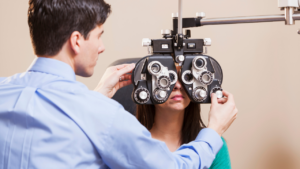November is Diabetic Eye Disease Awareness Month

More than 5.7 million Canadians live with diagnosed diabetes, and over 1 million Canadians are diagnosed with diabetic retinopathy, the most common form of vision loss associated with diabetes. The longer the diagnosis, the higher risk you are of experiencing vision loss and other vision problems caused by diabetes.
Diabetic Eye Disease is a series of conditions including blurry vision, cataracts, glaucoma, and diabetic retinopathy caused by elevated blood sugar levels. We recommend annual diabetic eye exams for people with diabetes, as it’s important to manage these conditions before they worsen.
During a diabetic eye exam, your ophthalmologist will look for changes in the blood vessels of the retina, which may indicate diabetic retinopathy. Diabetic retinopathy develops when blood vessels in the eye are exposed to high blood glucose levels for a prolonged period of time, which weakens the walls of the blood vessels in the eyes. This can lead to changes in vision, such as seeing dark spots, having blurry vision, and blindness.
Yearly diabetic eye exams are important to help find diabetic retinopathy early, as you may not notice a change in your vision until diabetic retinopathy is advanced. Diabetic retinopathy can get worse if left undetected and untreated.
What Happens During a Diabetic Eye Exam?
During your diabetic eye exam, our ophthalmologist will start by asking you about your medical and vision history. Next, you’ll be tested on your visual acuity by reading an eye chart. This will help the ophthalmologist determine your clarity of vision.In most diabetic eye exams, our ophthalmologist will examine the retina in the back of your eye using an instrument called an ophthalmoscope. Drops are administered to dilate your pupils, giving the ophthalmologist a better visual of the back of the eye.
We may also conduct a fluorescein angiography test, which is used to reveal changes in the structure and function of the retinal blood vessels. For the test, your doctor will inject a fluorescent yellow dye into one of your veins and photograph your retina as the dye outlines the blood vessels. The images can pinpoint blood vessels that are closed, broken, or leaking. This is a sign of diabetic retinopathy.
It is recommended that people with diabetes have an eye exam every year, or as recommended by our team at Beyond Vision. Early eye damage can occur without pain, redness or blurred vision, so people with diabetes need to have their eyes examined regularly by an optometrist or ophthalmologist to ensure changes are detected early.
There is no cure for diabetic retinopathy, however, there are precautions that can be taken to slow the progression. If you have mild or moderate diabetic retinopathy, you may not need treatment right away. Our skilled team will monitor your eyes to determine when treatment is necessary.
Treatment options for those with advanced diabetic retinopathy include:
- Injecting medications into the eye
- Photocoagulation, a laser treatment that can stop or slow the leakage of blood and fluid in the eye
- Panretinal photocoagulation, a laser treatment that can shrink the abnormal blood vessels
- Vitrectomy, a procedure that uses a tiny incision in your eye to remove blood from the middle of the eye
Learn more about Diabetic Eye Exams at Beyond Vision and schedule your appointment using our convenient online scheduler.

